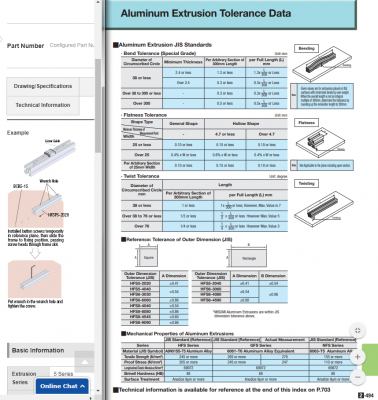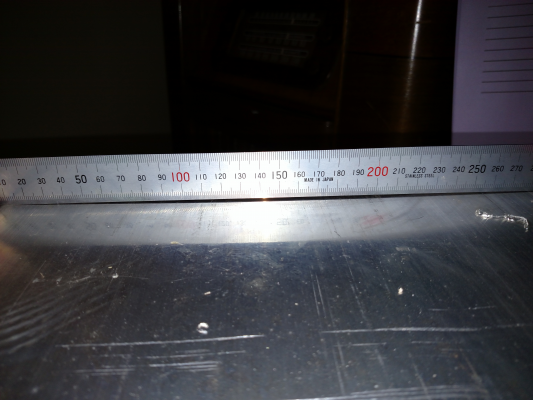|
Beware : Extruded profiles can be bended or twisted, while remaining standard ! January 29, 2019 12:31PM |
Registered: 10 years ago Posts: 150 |
I am in the production phase of my Zatsit delta printer, and I would like to share my experience with extruded aluminium profiles.
While remaining perfectly within standards, the extruded profiles that can be purchased at retail may have curvatures or twists that are actually incompatible with linear, direct or indirect guidance applications.
The profiles are extruded in long lengths, then cut to size for resale. The problem is that, in the most common manufacturing processes, the central part of the extruded bars is generally quite straight. Curvature and twisting problems appear more towards the extremities.
When you buy a retail profile, you can find a straight, twisted or curved copy, depending on where it was cut, without being able to complain about a non-standard supply.
For direct guidance on the profile applications (as is often the case with deltas), it would be necessary to be able to sort the straight copies. If the extrusion supports another linear guide, such as the ubiquitous MGN12, special profiles should be used for this application, milled after extrusion, as proposed by MISUMI.
I think this problem is very common among consumer 3D printers, or DIY. To appreciate it, you need a granite control surface, you can't, generally, see it with the naked eye. But it's very real: you can have, on a 1m bar, up to several mm of camber or twisting!
I think it doesn't show up on the printed parts either, because other defects are present, and make this one secondary. But it is certain that a curved profile will impose its bending on the printed part. In some overconstrained kinematics, this can also cause mechanical problems.
For Zatsit, I made sure that the manufacturer only provided me with parts cut in the centre of the bars, and I bought a granite control slab, so that I could sort as a last resort.
While remaining perfectly within standards, the extruded profiles that can be purchased at retail may have curvatures or twists that are actually incompatible with linear, direct or indirect guidance applications.
The profiles are extruded in long lengths, then cut to size for resale. The problem is that, in the most common manufacturing processes, the central part of the extruded bars is generally quite straight. Curvature and twisting problems appear more towards the extremities.
When you buy a retail profile, you can find a straight, twisted or curved copy, depending on where it was cut, without being able to complain about a non-standard supply.
For direct guidance on the profile applications (as is often the case with deltas), it would be necessary to be able to sort the straight copies. If the extrusion supports another linear guide, such as the ubiquitous MGN12, special profiles should be used for this application, milled after extrusion, as proposed by MISUMI.
I think this problem is very common among consumer 3D printers, or DIY. To appreciate it, you need a granite control surface, you can't, generally, see it with the naked eye. But it's very real: you can have, on a 1m bar, up to several mm of camber or twisting!
I think it doesn't show up on the printed parts either, because other defects are present, and make this one secondary. But it is certain that a curved profile will impose its bending on the printed part. In some overconstrained kinematics, this can also cause mechanical problems.
For Zatsit, I made sure that the manufacturer only provided me with parts cut in the centre of the bars, and I bought a granite control slab, so that I could sort as a last resort.
|
Re: Beware : Extruded profiles can be bended or twisted, while remaining standard ! January 29, 2019 03:11PM |
Registered: 11 years ago Posts: 335 |
Although the allowable tolerances are quite broad, extrusions are often straighter than they are rigid. I've put several lengths of Misumi extrusion against a surface plate and I've never been able to get a feeler gauge below it.
A length of 2020 extrusion is probably moving >0.1mm under load, so bend or twist of that magnitude will probably blend in with a slew of other misalignments.
Most 3d printers aren't designed for geometric accuracy. I'm honestly not sure I could assemble an extrusion delta with alignments better than +-0.5mm/300mm. Every time you align one column the other two will move, and there are too many degrees of freedom.
Technically even milled extrusions are not intended to mount rails in isolation, the only controlled dimension is thickness. You are supposed to make a sandwich of linear rail, extrusion, and reference plane:
As long as the motion isn't binding you can grid level and print cosmetic parts.
Edited 1 time(s). Last edit at 01/29/2019 03:12PM by 691175002.
A length of 2020 extrusion is probably moving >0.1mm under load, so bend or twist of that magnitude will probably blend in with a slew of other misalignments.
Most 3d printers aren't designed for geometric accuracy. I'm honestly not sure I could assemble an extrusion delta with alignments better than +-0.5mm/300mm. Every time you align one column the other two will move, and there are too many degrees of freedom.
Quote
M_Xeno
For direct guidance on the profile applications (as is often the case with deltas), it would be necessary to be able to sort the straight copies. If the extrusion supports another linear guide, such as the ubiquitous MGN12, special profiles should be used for this application, milled after extrusion, as proposed by MISUMI.
Technically even milled extrusions are not intended to mount rails in isolation, the only controlled dimension is thickness. You are supposed to make a sandwich of linear rail, extrusion, and reference plane:
As long as the motion isn't binding you can grid level and print cosmetic parts.
Edited 1 time(s). Last edit at 01/29/2019 03:12PM by 691175002.
|
Re: Beware : Extruded profiles can be bended or twisted, while remaining standard ! January 29, 2019 07:52PM |
Registered: 11 years ago Posts: 5,780 |
Extruded anything is liable to be twisted/bent which is one reason why I don't use t-slot with wheeled carriages for linear motion for anything that requires precision/accuracy. I saw a youtube video of aluminum extrusion once- IRIC, after extrusion it was put into a machine that stretched it while it was still hot.
Extruder aluminum plate is often far from flat- here's a piece I bought several years ago before I knew about cast tooling plate:
Ultra MegaMax Dominator 3D printer: [drmrehorst.blogspot.com]
Extruder aluminum plate is often far from flat- here's a piece I bought several years ago before I knew about cast tooling plate:
Ultra MegaMax Dominator 3D printer: [drmrehorst.blogspot.com]
|
Re: Beware : Extruded profiles can be bended or twisted, while remaining standard ! February 04, 2019 03:33PM |
Registered: 5 years ago Posts: 71 |
Quote
691175002
Although the allowable tolerances are quite broad, extrusions are often straighter than they are rigid. I've put several lengths of Misumi extrusion against a surface plate and I've never been able to get a feeler gauge below it.
Bosch Rexroth style 2020 extrusion usually has very high dimensional accuracy in the profile geometry as well. The JIS standard Misumi conforms to is 20mm +/-0.41mm for max allowable profile dimensions. But I've measured many profiles from both domestic and other suppliers, and all were within 20mm +.02 and -.10 (with one odd outlier). Misumi is the larger one at 20.00-20.02, while everyone else almost always falls in at 19.90-19.95.
Sorry, only registered users may post in this forum.

